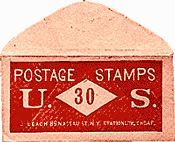
At the onset of the Civil War, hoarding of precious metal coinage dried up the marketplace and forced merchants and public alike to adopt queer measures as remedies. Since necessity is often the "mother of invention," it should surprise no one that even postage stamps were resorted to in making small change at the time.
Almost overnight, $25 million in small change had disappeared from the channels of commerce. Although many people had coins stashed away, they were reluctant to spend them fearing additional inflation would drive the coins' value higher and they would lose out.
Even in today's increasingly cashless society, we can well image what our lives would be like without small change. In 1862, it was much worse - prices were a fraction of what they are today for most items. A quarter was a good deal of money. Three cents would buy a newspaper or a stage ride. Five cents would buy a glass of beer and a lunch. Not getting one's change from even a small purchase was intolerable.
The public turned to the only generally available medium at hand, and seized upon the postage stamps for small change. Merchants were forced to accept this substitute. Even the odd denomination postage stamps such as 12 cents and 30 cents were better than most other substitutes, or worse yet, no change at all.
Shopkeepers posted signs such as "postage stamps received for goods and given in change." Similar announcements appeared in advertisements in the newspapers. Some merchants even advertised to sell stamps (at a premium) to change-hungry customers.
Stamp sales rose precipitously at post offices nationwide. In New York City, daily stamp sales rose from $3,000 to $25,000! In its optimism and hysteria to employ stamps in its purchases, the public rushed thousands of dollars worth of these miniature "gum backs" into circulation, despite their obvious disadvantages. "To hand a New York stage driver his fare of two three-cent postage stamps on a wet day, or to buy a newspaper on a windy street corner" with this miniature currency often proved difficult.
The public's euphoria with this small change substitute passed quickly. The grave drawbacks of such a poor change substitute became quickly apparent. Eventually these sticky, adhesive stamps soon soiled and collected into messy wads in the bottoms of pockets and purses, after repeatedly changing hands in the market place.
These drawbacks necessitated a 'Plan B' remedy for the motley miniature currency. In New York City, Harnden's Express suggested in a New York Herald editorial that the stamps should be placed in small, neat envelopes especially made for that purpose. The sum of the stamps contained within could be printed on the outside of these envelopes, the firm said.
Many felt that Harnden's proposal was an ingenious solution. Within these envelopes, stamps would stay clean and dry and also retain their postal value. Printers rushed to their presses and struck off dozens of samples. Murphy's, a New York printer, advertised that it would supply these small postage stamp envelopes for 75 cents per thousand. Other printers followed suit.
Inexpensive to produce, but very functional, the stationers soon found a ready market for their diminutive postage stamp envelopes. They even offered to customize them to their clients' needs. Soon large merchants, realizing the advertising value of having their name imprinted on these postage stamp currency envelopes, ordered envelopes printed in various values.
Collectors today have identified more than 200 varieties of these currency substitutes. Fifty cents was a common denomination for these postage stamp envelopes, although various denominations from 5 cents to 75 cents are known. Others were left valueless, and the sum of stamps was written on the outside.
Issue of these envelopes centered in the large eastern seaboard cities. Hotels and retail merchants were the predominant issuers. Many varieties issued by the stationers themselves are also known. All varieties are at least scarce, and many are extremely rare. Prices range from $250 to $750 for highly desirable issuers. Envelopes with their stamps still inside are especially prized.
Fred Reed is former News Editor of Coin World and Vice President of Beckett Publications. A collector for 40 years, Reed is a member of most national coin and stamp organizations. He is also Secretary of Society of Paper Money Collectors. SPMC awarded Reed its lifetime achievement award for his groundbreaking Civil War Encased Stamps: The Issuers and Their Times, one of his five books. Reed has also written on coins and currency, tokens and medals, stamps, comic books, post cards, Beanie Babies, sports cards and collectibles, engravings and lithographs, movie memorabilia, autographs, antique photography, and Civil War artifacts, all of which he avidly collects. He is currently penning two books on the entertainment careers of professional athletes; another on the first family of American sculpture, James Earle Fraser and Laura Gardin Fraser; yet another titled Abraham Lincoln Pictorial Treasury; one on the career and collectibles of Yogi Berra and a murder mystery set during the 1870 baseball season. Reed is a long time member of the American Society of Magazine Editors, the Dallas Press Club and the Society for American Baseball Research.